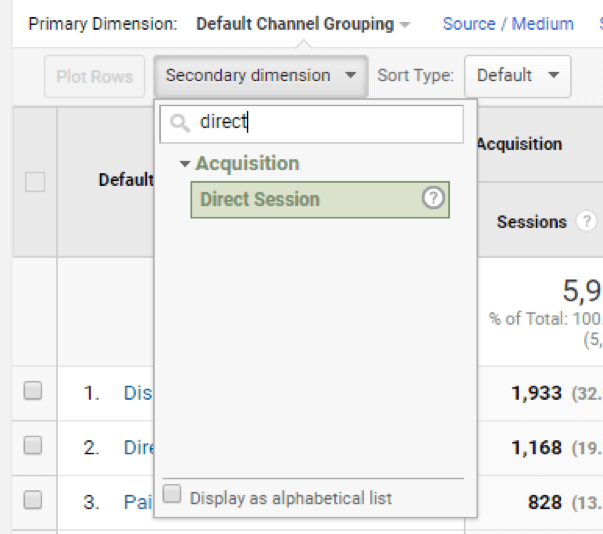Improve Your Data Analysis with Secondary Dimension in Google Analytics
Improve Your Data Analysis with Secondary Dimension in Google Analytics
Blog Article
Unlock Deeper Insights With Second Measurement in Google Analytics
With the large area of data readily available in Google Analytics, the use of second dimensions can considerably improve your analytical capacities. By strategically incorporating secondary dimensions into your analysis, you can discover important insights that could or else remain undiscovered - Secondary Dimension in Google Analytics.
Understanding Primary Vs. Additional Dimensions
When examining information in Google Analytics, it is important to differentiate between additional and main dimensions to gain much deeper insights into customer actions. Main measurements are the main categories through which you can watch your data, such as landing, device, or source/medium web page. These dimensions provide the fundamental structure for organizing and understanding your data. On the various other hand, second measurements enable you to further study your primary measurement data. By adding a secondary dimension, you can layer on extra info to your key dimension, allowing a much more granular evaluation. If your key dimension is the source/medium via which individuals showed up on your website, adding a secondary measurement like geographic location can expose where those users are situated geographically. This added layer of details can assist you identify patterns, patterns, or anomalies that might not have been obvious when checking out the primary measurement alone. Leveraging both additional and key dimensions in Google Analytics is critical for thorough data evaluation and educated decision-making.
Utilizing Secondary Dimensions Properly
Successfully using second dimensions in Google Analytics enhances the deepness and granularity of information evaluation, providing beneficial understandings into user behavior and fads. By integrating additional dimensions along with main measurements, analysts and marketing professionals can delve deeper into the specifics of customer communications on their internet sites. Secondary dimensions allow users to segment and filter primary measurement information additionally, supplying a much more comprehensive view of customer demographics, actions, and interactions. This can be particularly useful when trying to comprehend the impact of certain variables on user involvement, such as the devices or browsers they are utilizing, the sources of their traffic, or their geographical places.
Moreover, additional dimensions allow users to compare and contrast different information points within a single record, helping with a more comprehensive analysis of customer behavior patterns. By leveraging additional measurements properly, businesses can discover surprise insights, optimize their advertising and marketing approaches, and enhance the general user experience on their websites.
Checking Out Usual Second Dimension Mixes
To additionally examine individual behavior and fads in Google Analytics, it is important to explore common combinations of second dimensions. Some common secondary dimension mixes that give valuable understandings include examining traffic resources with user locations to understand where web site site visitors are coming from geographically and how they found the site. Taking a look at individual habits metrics with additional dimensions such as rate of interests or demographics can assist in targeting particular target market sectors extra effectively.
Applying Secondary Dimension in Custom Information
Making use of secondary dimensions in next custom-made records permits a more check my reference thorough analysis of information in Google Analytics, enhancing the deepness of understandings obtained. When producing personalized reports in Google Analytics, integrating second dimensions can offer a much more in-depth sight of how various dimensions communicate with each other. This feature enables users to dive deeper into their information and reveal beneficial relationships that may not be promptly apparent.
By applying secondary dimensions in personalized reports, customers can gain a far better understanding of their website or application traffic. As an example, combining the primary dimension of "source/medium" with the additional dimension of "touchdown web page" can disclose which touchdown web pages are performing finest for web traffic coming from particular sources. This insight can aid marketing professionals enhance their campaigns and boost general conversion rates.

Enhancing Data Visualization With Second Dimension
When discovering information in Google Analytics personalized records, integrating second measurements not just supplies a much more in-depth evaluation yet additionally improves the graph of understandings via information visualization. By adding an additional measurement to your records, you can enrich the way information exists, making it simpler to recognize patterns, fads, and connections within your website's performance metrics.
Additional dimensions can assist you section your information further, allowing for a much deeper understanding of customer actions and communications Click Here on your website. This enhanced degree of granularity can be specifically useful when attempting to separate certain variables that might affect your website's performance - Secondary Dimension in Google Analytics.
Conclusion
In verdict, leveraging second measurements in Google Analytics enables a more thorough analysis of data, bring about much deeper insights and even more enlightened decision-making. Secondary Dimension in Google Analytics. By adding extra layers of info to key data collections, marketing professionals and experts can uncover covert trends, patterns, and correlations that offer a granular sight of user habits and communications. This improved level of insight enables optimization of campaigns and customized approaches for specific audience sections, inevitably improving efficiency and conversion rates
On the other hand, second dimensions permit you to further study your key measurement data. By including a second dimension, you can layer on extra information to your main dimension, allowing a much more granular analysis. If your key measurement is the source/medium through which individuals arrived on your website, adding a secondary dimension like geographical location can expose where those customers are located geographically. By including second dimensions alongside key dimensions, analysts and marketers can delve much deeper into the specifics of customer interactions on their websites. Additional measurements permit customers to segment and filter main measurement data even more, providing a more detailed sight of customer interactions, demographics, and actions.
Report this page